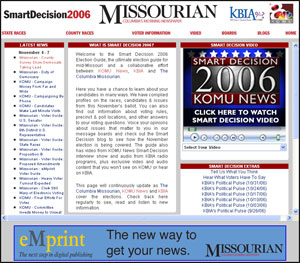Collaborative Merge of KBIA, KOMU and the Missourian Newsrooms Creates a New Convergence Experience for Students
By Alexandra Rampy
Columbia, Mo. (Nov. 10, 2006) — Missouri Journalism students and faculty from all areas of study recently participated in a groundbreaking convergence project called “Smart Decision,” a multimedia Web site that provided in-depth coverage of the 2006 state and local mid-term elections.

Smart Decision, which launched earlier this semester, gave students across all emphasis areas the opportunity to work with the School’s innovative, experienced faculty in producing content for the interactive Smart Decision Web site. Three of the School’s professional media outlets, whose newsrooms also double as learning laboratories for students, were involved in the project: the Columbia Missourian, an award-winning community newspaper; KOMU, mid-Missouri’s NBC affiliate; and KBIA, one of the most successful NPR stations in the country. Because one goal of the project was to increase visits to each organization’s Web site, the Smart Decision link was accessible through each medium’s home page. Traffic to KOMU.com more than tripled on Election Day, and hits on the Missourian’s Web site nearly doubled in the days surrounding the election.
“I’ve worked on a couple multimedia type projects while at Missouri, but this election guide is the first convergence project to combine all three of the School of Journalism’s media outlets of this magnitude,” said Shawn Brouwer, a senior convergence journalism major from Visalia, Calif. Brouwer began working on the project as part of his capstone course, which is an opportunity for students to demonstrate skill proficiency and a working knowledge in the subject area.
Brouwer said his involvement with the project taught him cutting-edge skills he will use as a professional in a rapidly changing field.
“Not only am I building on what I worked on this summer at my internship with USATODAY.com and other smaller convergence projects within the School, but I’m also learning more about Flash, video-shooting and producing and writing for blogs,” Brouwer said.
Jennifer Reeves, assistant professor of radio-television journalism and new media manager at KOMU, was one of the driving forces behind the Smart Decision project. Reeves said Smart Decision is the School’s latest attempt to find new, creative ways to develop interactive content on the Web.
“The convergence arena of journalism is developing so rapidly, especially with the pace of changing technology, that this project allows us a truly collaborative effort involving students and faculty spanning the three newsrooms,” Reeves said. “We’re helping students find ways to take journalism beyond the norm and communicate beyond the newsrooms. It’s a wonderful opportunity for everyone in the newsroom to learn how to work together and apply new technology so that student journalists gain experience and our consumers gain more access to information.”
Reeves said the Smart Decision concept was the product of brainstorming about new ways KOMU could cover the 2006 election. She presented the ideas to KOMU General Manager Marty Siddall, who was enthusiastic but worried the project might be too expensive for the station. Because of this concern, Siddall and Reeves decided to talk with the other newsrooms affiliated with the School. Thus, the idea for a collaborative effort between KOMU, KBIA and the Missourian was born. Students in classes taught by Reeves, Lynda Kraxberger, associate professor of convergence journalism, and Mike McKean, chair of convergence journalism, initiated work on the project.

“KOMU really took the ball and ran with it as they are the ones that approached the Missourian about working on the project together,” said Scott Swafford, assistant professor of newspaper journalism and Missourian city editor. “The goal of the project is really two-fold. One, it provides our various audiences what will be a comprehensive resource about all the candidates. Secondly, from an academic viewpoint, it provides experience in covering politics for our convergence students. For my Missourian reporters who are reporting on issue stories and personality profiles of the candidates for the Smart Decision project, it’s showing them first hand what multimedia can add to their stories by rounding them out with video and sound.”
Faculty and students from across the School generated content for Smart Decision. For instance, as part of the project, KOMU anchors and KBIA News Director Sarah Ashworth posted video logs on the Smart Decision Web site, and some Missourian reporters kept online logs of their experiences as well.
Lee Wilkins, professor of radio-television journalism, had her ethics class write reviews of candidates’ political advertisements to include on the Web site. Also featured on the Web site were video interviews of candidates and questionnaires the candidates themselves filled out.
One major component of the project was a live, interactive guide for election night. Reeves said their goal was to create a space where online consumers could go for complete coverage, in addition to highlighting Missouri’s heated U.S. Senate race between incumbent Republican Jim Talent and Democrat Claire McCaskill.
Streaming, wall-to-wall video of returns on Election Day was another important feature on the Smart Decision site.
“That was a technical accomplishment that has never been done before in this market, and it provided information on demand — information at our audience’s discretion rather than at the mercy of network news’ available slots for our regular on-air cut-ins,” Kraxberger said.
Although Smart Decision is the largest convergence journalism project the School has undertaken, it is not the first. KOMU and Missourian reporters traveled to New Orleans in 2005 to cover the aftermath of Hurricane Katrina and posted blogs of their experiences. They also collaborated on video and print reports and interviews.
“Each newsroom has strong product-specific skills and content that work for its medium,” Reeves said. “But projects like Smart Decision and the New Orleans package allow each newsroom to have a deeper pool of news content and to display it in an innovative way.”
Missouri’s emphasis on hands-on learning, the foundation of the Missouri Method, not only helps students develop the skills they’ll need to be successful convergence journalists, but also helps guide their career paths.
“Experience is always important because it helps you figure out exactly what you want to do out in the real world,” Brouwer said. “There are so many things you can do coming out of the convergence emphasis that every opportunity helps me figure out what I want to do.”
Smart Decision Site Features
A combined project of the Columbia Missourian, KBIA and KOMU, the Smart Decision Web site contains:
-
- Amendment Profiles
- Boone County Voter Information
- Candidate Profiles
- Discussion Boards
- eMprint Voter Guide
- Issue Stories
- KBIA Sound Clips
- KOMU Video
- Missourian Stories
- Online Poll
- Reviews of Political Advertisements
Alexandra Rampy, a senior from Overland Park, Kan., is an advertising major and business minor. She has interned at Muller + Company, a full-service advertising agency in Kansas City, Mo., and been involved in Rockin’ Against Multiple Sclerosis, the MU Student Foundation, Adelante! and Alpha Phi Fraternity. Rampy plans to study strategic communication in graduate school and one day would like to found a non-profit advertising agency.
Updated: April 15, 2020